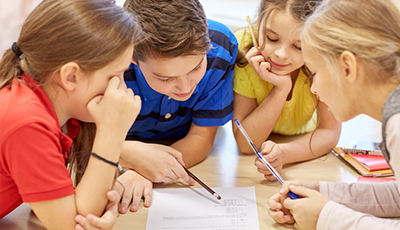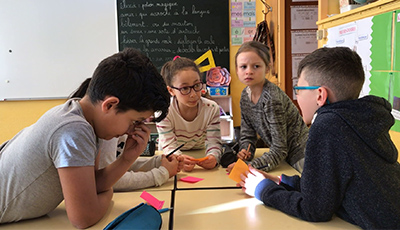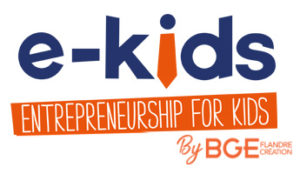Everything you need to know about e-kids
A turnkey tool

E-kids is a « turnkey » tool that is made up of:
- On-line educational resources that are fun and motivational to help teachers run class projects
- A box featuring evaluation tools that offer encouragement to pupils (pride table, messages that challenge and reward pupils, inspirational posters, etc.)
- Personalised support
Discover e-kids
The educational goals

E-kids allows primary school pupils to experience every stage of an entrepreneurial adventure.
Every pupil is invited to:
- Identify needs or problems that exist in their local environment (family, neighbourhood)
- Select a project by reaching a consensus to find a realistic and innovative solution.
- Plan a project aimed at dealing with the problem or need identified: plan the tasks required, define the responsibilities of everyone involved, identify the resources required, seek out partners, anticipate difficulties and the ways to overcome them.
- Carry out a project within a timeframe and adjust it in light of any problems encountered.
- Evaluate the project using individual reports about the experience, the analysis of benefits and thoughts on how it could have been improved.
Take a look at some testimonials from our little entrepreneurs.
The entrepreneurial project

An entrepreneurial project is a project that offers something new in order to meet a need or solve a problem through the creation of an object, a service or an event. The primary objective is to show the pupils that they can have an impact on their environment by tackling the problems that they encounter.
These needs and problems can be based around a certain theme: health, community, the environment, citizenship…Every project should stand out because of its usefulness to the group and should produce positive results and feedback.
Throughout the creation and realisation of the entrepreneurial project, the teacher can carry out each individual step alongside the pupils or delegate all responsibility entirely to them. In any case, pupils should be able to express their creativity and ought to feel free to take the initiative. The teacher must ensure that the pupils have the means and the time required to carry out their project.
There are as many entrepreneurial projects as there are children!
The method

Thanks to the e-kids tool pupils can enjoy experiences, develop their own entrepreneurial qualities, work together and perfect things they have learned at school. This initiative gives pupils the chance to use aspects of language learning, mathematics and other subjects without realising it. E-kids also offers the opportunity to reinforce the links between school, pupils and parents.
By placing them in the situation of being responsible for a real project, pupils are able to experience new learning situations that are particularly rich and make use of their own knowledge and abilities.
Discovering
myself
and others
Step 1: the pupils learn to know themselves. They become aware of their qualities and their talents. They identify their passions and areas of interest. The qualities of each pupil are assessed by the entire group, giving each pupil a new point of view on who they are. The teacher assists the pupils and allows them to become aware of their progress thanks to adapted educational materials.
The idea
Step 2: pupils are able to develop their creativity. They become aware of other qualities as the entrepreneurial project unfolds.
The teacher shows the pupils how they can come up with original and innovative ideas that allow them to meet the needs of their community: their family, their school, the local area. The teacher runs brainstorming sessions designed to uncover a maximum of creative ideas from which a project will be selected.
From ideas
to
actions
Step 3: selecting the most original idea on the basis of its feasibility, originality and usefulness. A vote can be held if there are several possible projects.
A « mind map » is then established by the pupils so that the entire project can be defined: How? Who? What? How much? Where? When? Why? A meeting with a real entrepreneur, who will visit the class, lets them define their ideas and prepare their actions.
Realisation
Step 4: the pupils carry out an entrepreneurial project and demonstrate that they are capable of adhering to a pre-defined timetable of tasks: respect the timetable, make use of facilities, mobilise partners, respect the set budget. Pupils learn to confront the ups and downs of the project and amend their plans in order to resolve problems.
Evaluation
Step 5: evaluating the completed project at a closing event that is open to all: parents, pupils and teachers from other classes, entrepreneurs, local authorities, press, and local residents with a connection to the project.
The pupils that carried out the entrepreneurial project are at the heart of this event. They have the opportunity to present the project and share their experience of being entrepreneurs. A diploma is presented to each pupil.
At the end of the activity, a complete report allows the pupils to become aware of their journey and realise what they have achieved.
How can you find a problem that needs solving?

In order to find a problem or a need that will be tackled by the entrepreneurial project, two approaches are open to teachers:
- Either ask the pupilsto suggest a theme (for example: what are the things that annoy you in daily life, what is missing from your local area?)
- Or suggest a subjectto work on.
Generally, the problem or the need identified should relate to a situation that it would be beneficial to change or an improvement that should be made in a certain field: heath, wellbeing, community life, citizenship…
This problem should concern a targeted public: pupils in the class or in other classes, parents, the local area…
Whatever suggestions are made, the teacher must ensure that the problem is sufficiently precise for the project to the carried out comprehensively.


